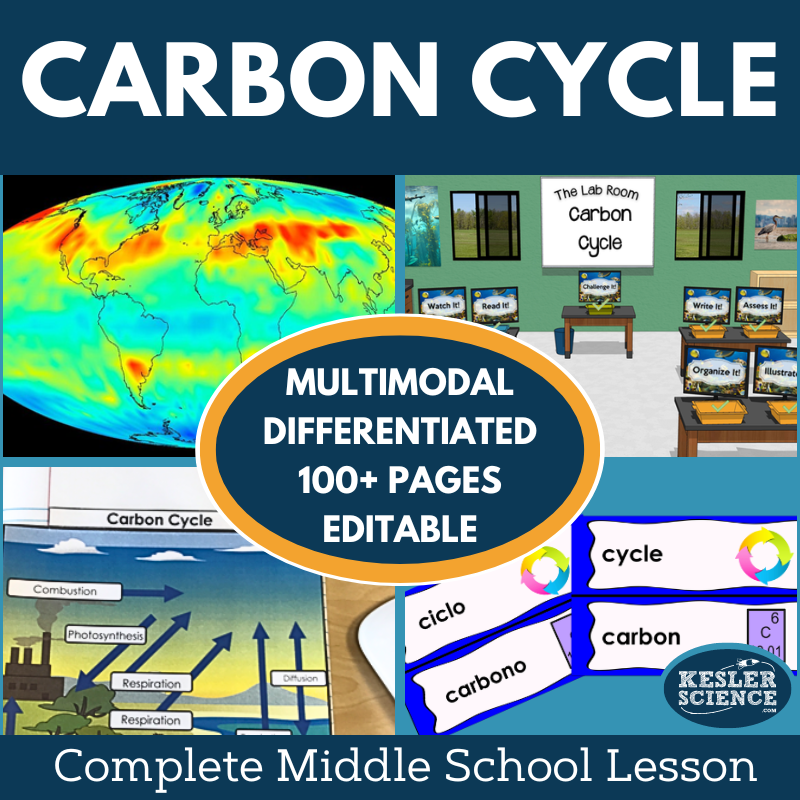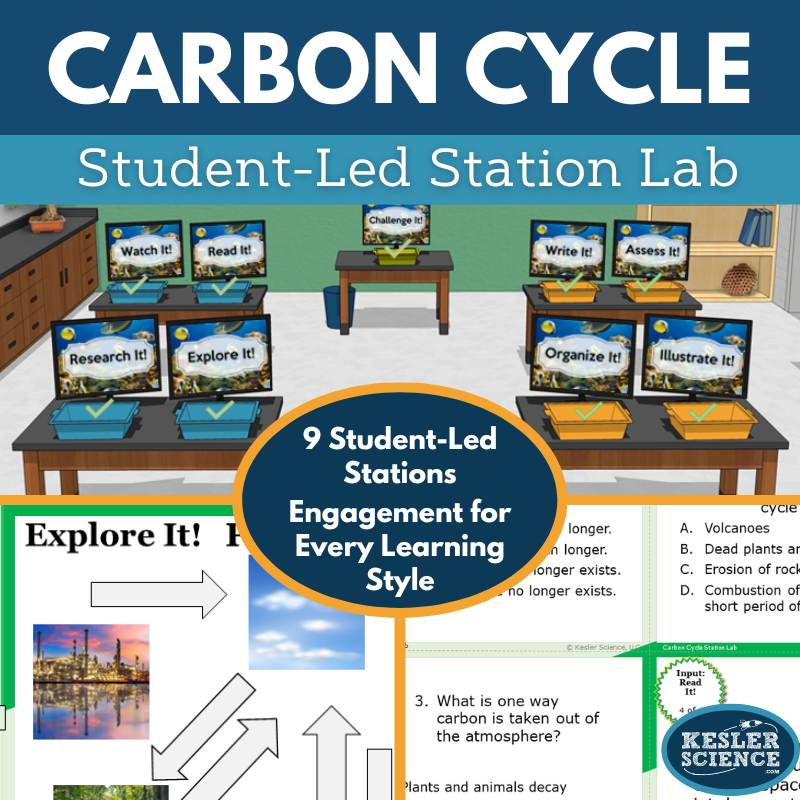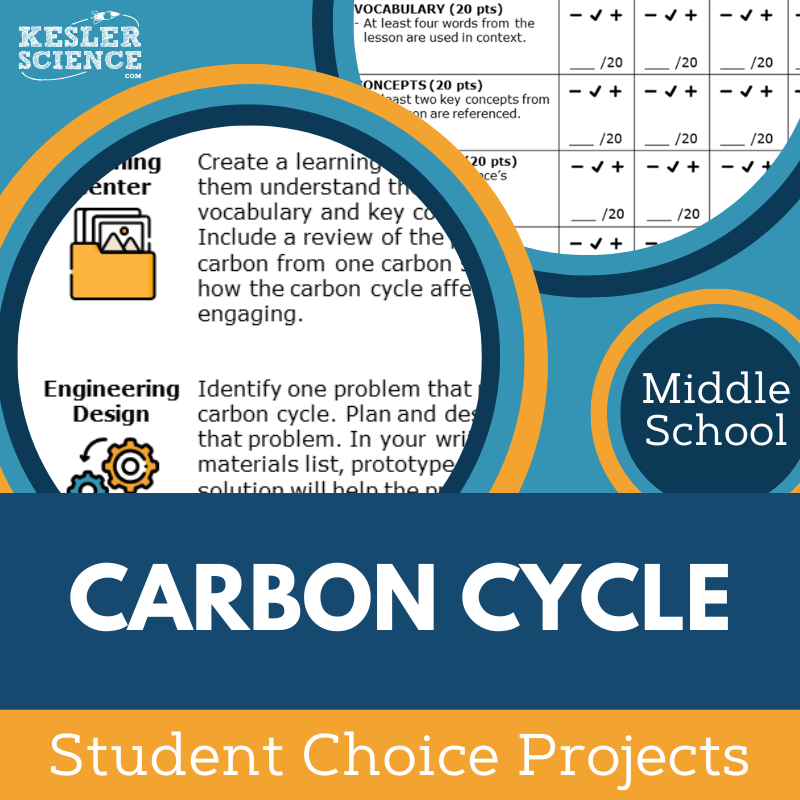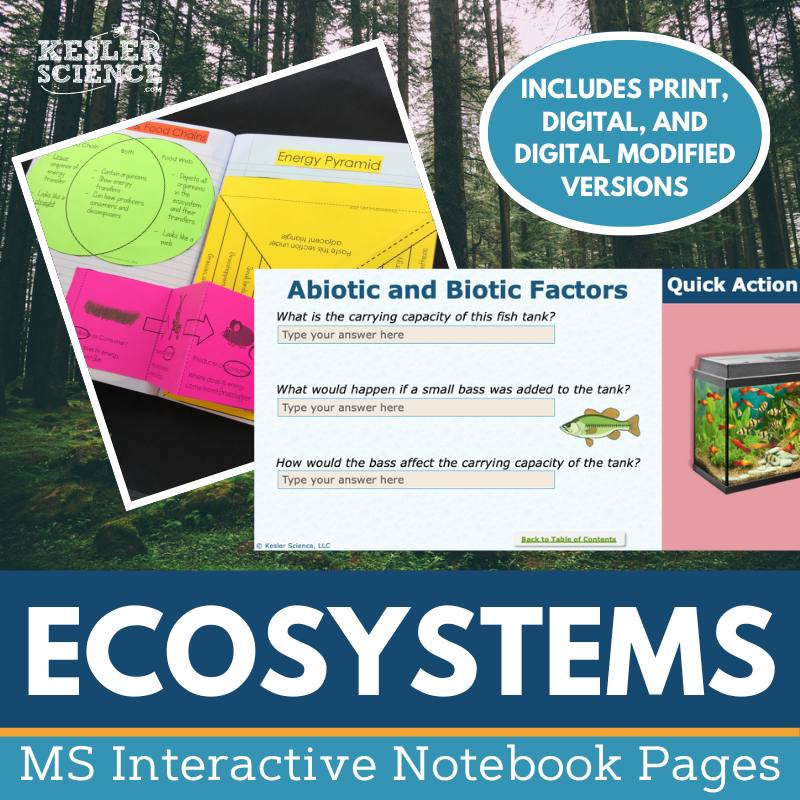Carbon Cycle Activities for Middle School Science
The Kesler Science Carbon Cycle resources provide middle school students with engaging, hands-on opportunities to explore key concepts such as respiration, combustion, and decomposition within the carbon cycle. The resources below will give students a comprehensive understanding of the carbon cycle. All of the following materials are also included in the Kesler Science Membership.
The Kesler Science Carbon Cycle Complete 5E Lesson provides all the resources needed for a multi-day, engaging lesson designed to maximize student success with minimal prep. This lesson is based on the 5E Model—Engagement, Exploration, Explanation, Elaboration, and Evaluation—and includes editable, differentiated, and multimodal materials to meet the needs of every learner.
Students begin by exploring the essential question, "How do microhabitats and biomes support different varieties of organisms?" The Exploration phase includes a differentiated station lab with nine input and output stations, such as "Explore It!" for hands-on experiments and "Illustrate It!" for creative visual learning. The Explanation phase features editable PowerPoints and interactive notebook templates in both English and Spanish to support comprehension and mastery.
The Elaboration and Evaluation phases allow for extended learning through student-choice projects and standards-aligned assessments. Whether used in a traditional classroom or virtual environment, this versatile lesson ensures middle school students stay engaged while mastering the concepts of the carbon cycle.
The Kesler Science Carbon Cycle Complete 5E Lesson provides all the resources needed for a multi-day, engaging lesson designed to maximize student success with minimal prep. This lesson is based on the 5E Model—Engagement, Exploration, Explanation, Elaboration, and Evaluation—and includes editable, differentiated, and multimodal materials to meet the needs of every learner.
Students begin by exploring the essential question, "How do microhabitats and biomes support different varieties of organisms?" The Exploration phase includes a differentiated station lab with nine input and output stations, such as "Explore It!" for hands-on experiments and "Illustrate It!" for creative visual learning. The Explanation phase features editable PowerPoints and interactive notebook templates in both English and Spanish to support comprehension and mastery.
The Elaboration and Evaluation phases allow for extended learning through student-choice projects and standards-aligned assessments. Whether used in a traditional classroom or virtual environment, this versatile lesson ensures middle school students stay engaged while mastering the concepts of the carbon cycle.
The Kesler Science Carbon Cycle Station Lab is a modular, student-led activity that offers a hands-on, engaging way for middle school students to investigate respiration, combustion, and decomposition. With differentiated activities and a student-centered approach, this lab empowers students to guide their own learning while teachers facilitate.
The lab includes nine stations, split into input and output activities for multimodal learning. Input stations like "Explore It!" and "Research It!" immerse students in hands-on demonstrations, research tasks, and reading passages (available in Spanish and English). Output stations such as "Organize It!" and "Illustrate It!" encourage students to creatively demonstrate their understanding through manipulatives, sketches, and written responses.
Equipped with signage, task cards, and editable resources, this lab is adaptable for both in-person and virtual learning. Digital options allow students to manipulate images and text in Google Slides or PowerPoint. The "Challenge It!" station provides advanced activities for early finishers, making this lab a versatile and engaging resource for ecosystems lessons.
The Kesler Science Carbon Cycle Station Lab is a modular, student-led activity that offers a hands-on, engaging way for middle school students to investigate respiration, combustion, and decomposition. With differentiated activities and a student-centered approach, this lab empowers students to guide their own learning while teachers facilitate.
The lab includes nine stations, split into input and output activities for multimodal learning. Input stations like "Explore It!" and "Research It!" immerse students in hands-on demonstrations, research tasks, and reading passages (available in Spanish and English). Output stations such as "Organize It!" and "Illustrate It!" encourage students to creatively demonstrate their understanding through manipulatives, sketches, and written responses.
Equipped with signage, task cards, and editable resources, this lab is adaptable for both in-person and virtual learning. Digital options allow students to manipulate images and text in Google Slides or PowerPoint. The "Challenge It!" station provides advanced activities for early finishers, making this lab a versatile and engaging resource for ecosystems lessons.
The Kesler Science Carbon Cycle Student Choice Projects give middle school students the freedom to showcase their understanding through creative, self-led projects. With six project options and a “design your own” choice, students can select the format that best suits their learning style. A detailed grading rubric supports assessment by teachers, peers, or students themselves, encouraging ownership of the learning process.
These flexible, multimodal projects cater to a variety of needs, with a modified version available for students requiring extra support. Advanced learners can be challenged with multiple projects, all assessed using the same editable rubric. The project-based approach promotes personalized learning while reinforcing key concepts like vocabulary, presentation skills, and understanding of the carbon cycle.
Requiring only basic classroom supplies, these projects are easy to implement and can be completed physically or digitally. From hands-on crafting to digital creations, the options are designed to engage and inspire students while making learning meaningful and interactive.
The Kesler Science Carbon Cycle Student Choice Projects give middle school students the freedom to showcase their understanding through creative, self-led projects. With six project options and a “design your own” choice, students can select the format that best suits their learning style. A detailed grading rubric supports assessment by teachers, peers, or students themselves, encouraging ownership of the learning process.
These flexible, multimodal projects cater to a variety of needs, with a modified version available for students requiring extra support. Advanced learners can be challenged with multiple projects, all assessed using the same editable rubric. The project-based approach promotes personalized learning while reinforcing key concepts like vocabulary, presentation skills, and understanding of the carbon cycle.
Requiring only basic classroom supplies, these projects are easy to implement and can be completed physically or digitally. From hands-on crafting to digital creations, the options are designed to engage and inspire students while making learning meaningful and interactive.
The Kesler Science Ecosystems Interactive Notebook Bundle provides an engaging and interactive way for students to explore key ecosystems concepts. Designed for flexibility, the resource includes both print and digital versions, making it suitable for traditional classrooms, 1:1 environments, and distance learning settings.
The bundle covers a wide range of topics, including biotic and abiotic factors, biomes, food webs, symbiosis, and the nitrogen and carbon cycles. Digital features include a unique interactive notebook PowerPoint, editable Google Slides compatibility, reflection pages, and modified versions for students with accommodations. The paper version includes blank and pre-filled templates, complete with color examples to guide students and teachers.
This resource supports differentiated instruction and accommodates all learners with thoughtfully designed templates and modifications. Whether in person or online, the Ecosystems Interactive Notebook promotes active learning, critical thinking, and scientific literacy.
The Kesler Science Ecosystems Interactive Notebook Bundle provides an engaging and interactive way for students to explore key ecosystems concepts. Designed for flexibility, the resource includes both print and digital versions, making it suitable for traditional classrooms, 1:1 environments, and distance learning settings.
The bundle covers a wide range of topics, including biotic and abiotic factors, biomes, food webs, symbiosis, and the nitrogen and carbon cycles. Digital features include a unique interactive notebook PowerPoint, editable Google Slides compatibility, reflection pages, and modified versions for students with accommodations. The paper version includes blank and pre-filled templates, complete with color examples to guide students and teachers.
This resource supports differentiated instruction and accommodates all learners with thoughtfully designed templates and modifications. Whether in person or online, the Ecosystems Interactive Notebook promotes active learning, critical thinking, and scientific literacy.
Year-Round Resources
These year-round activities will increase your students' understanding of many middle school science topics. All of these activities are also included in the Kesler Science Membership.
Visual Data & Graphing
You're not alone if your students struggle with understanding graphs, charts, and tables. It's a skill that takes an enormous amount of practice. This resource will help students build a strong foundation in analyzing data and creating their own data visualizations.
Bell Ringers and Warm-Ups
These middle school science bell ringers are an excellent way to engage your students as soon as they walk into your classroom. This comprehensive FULL YEAR resource includes everything you need to start off each science class with an interesting warm-up activity.
Review Board Games
Each game board has been carefully designed to keep students engaged. There are 10 different action spaces on each board and dozens of question cards. All of the actions are related to science concepts and keep the students motivated throughout the game.
Each game is ready to play. Simply print out the board and the cards and let the students enjoy reviewing nine different units.
Essential Questions
Below are the essential questions associated with the lessons and activities included in this unit. This topic is only one of more than 100 middle school science topics included in the Kesler Science Membership.
-
How do microhabitats and biomes support different varieties of organisms?
Kesler Science Membership
Imagine never having to search for another middle school science lesson again. The membership gives you access to ALL of the Kesler Science products in one place (Yes, including everything above).
Say goodbye to long hours of lesson prep.









